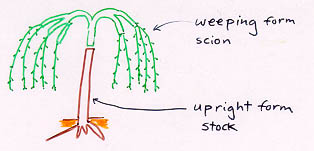PRINCIPLES OF GRAFTING AND BUDDING
I. WHY GRAFTING AND BUDDING?
A. Perpetuation
of Clones
-Cultivars
that can not be maintained by cuttings, layers, divisions, etc.
i.e. Eucalyptus, spruce, oak
-Heterozygous
woody plants in adult growth phase
i.e. juvenility delays fruiting when seedling-grown
-Maintaining
certain lines in breeding
B. Benefits of
Certain Rootstocks
-Used
when plants are selected for ornamental or fruit characteristics not for
root adaptability
plants are then grafted on to rootstocks adapted to poor soil conditions
-Used
to control plant size
i.e. East malling apple rootstocks dwarf grafted plants----> dwarf apple
-Use of
disease resistant rootstocks
i.e. Greenhouse cucumber grafted onto rootstocks resistant to Fusarium,
verticillium wilts
-Use of interstocks
-desirable interstock combined with disease resistant scion and adapted rootstock
C. Changing
Cultivars of Established Plants (topworking)
-When
a new cultivar needs to be grown on an established orchard
-When a different cultivar is needed for pollination in a single-cultivar orchard
-Inducing
fruit set on pistillate plants of a dioecious species
-Producing
fruits of different cultivars on the same plant
i.e. apple, pear, citrus, apricot, peach, etc.
-Producing
different color flowers on the same tree
i.e. Rose
D. Faster Maturity
in Seedling Selections
-Reduces
time required to reach a reproductive maturity
ex. a seedling plant takes 5-10 years to bloom
but the same seedling grafted on a rootstock blooms in 2-3 years
-Increases
vigor in seedling-grown plant when grafted
i.e. Chinese lilac hybrid (Syringa laciniata x S. vulgaris)
is grafted on S. amurensis japonica to give vigor and
flowering
E. Combining
Special Forms
-Unusual
type of growth habit
i.e. weeping mulberry
-Cactus grafting
F. Repairing
Damaged Trees
-Approach
graft
-Bridge
graft
G. Study of
Virus Diseases
-Scion
or buds of suspected plants are grafted on to an indicator plant for symptom
development
examples
II. GRAFT UNION
The sequence of healing events after grafting
1) Lining up of vascular cambiums
-the cambium
layers of scion and stock must be lined up
2) Formation of necrotic material
from cells on the wound site----- healing response
3) Callus bridge formation
-parenchyma
cell mass produced from the cambial layers fills up the spaces between scion
and stock
4) Cambium formation
-certain
cells of the callus line up forming a cambium layer connecting the cambiums
of both the scion and the stock
5) Vascular tissue formation
-xylem
inside
-ploem
outside